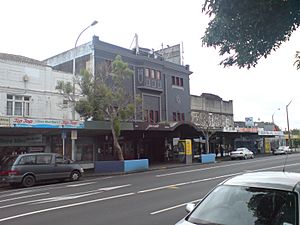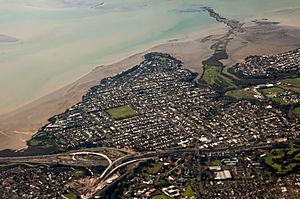Point Chevalier facts for kids
Quick facts for kids
Point Chevalier
|
|
|---|---|
|
Suburb
|
|

Point Chev town centre along Great North Road, the old picture theatre is shown in the middle
|
|
| Country | New Zealand |
| Local authority | Auckland |
| Electoral ward | Albert-Eden-Puketāpapa ward |
| Local board | Albert-Eden Local Board |
| Established | 1920s (Approx.) |
| Area | |
| • Land | 275 ha (680 acre) |
| Population
(June 2023)
|
|
| • Total | 8,500 |
|
|
||
Point Chevalier (pronounced like "shuh-VAL-ee-air"), often called Point Chev, is a cool neighbourhood in Auckland, New Zealand. It's a suburb that sits on a piece of land sticking out into the water, called a peninsula. You can find it about five kilometres west of Auckland's city centre, right on the southern shore of the Waitematā Harbour.
Point Chevalier was once a place where many working-class families lived. Over the years, it has grown and changed into a middle-class area. Many new buildings and projects have been built. The suburb is famous for its special "Californian style bungalows," which are a type of house. Point Chev stretches from its main shopping area on Great North Road all the way to the tip of the peninsula in the north. Its postcode is 1022.
Contents
Exploring Point Chevalier's Geography
Point Chevalier is located north of State Highway 16. It is also west of the Western Springs neighbourhood. Most of Point Chev is on a triangular peninsula. This land sticks out into the harbour for about 1,800 metres.
The soil here is mostly clay. It doesn't have the rich volcanic soil found in other parts of Auckland. This means the plants and trees in Point Chev might not look as lush as in some other areas.
Meola Reef and Local Parks
From Coyle Park, you can see Meola Reef. This reef is a long stretch of black rock that goes into the Waitematā Harbour. It's actually the end of a lava flow from the Three Kings volcano, which is several miles south. Meola Reef used to be a landfill, but now it's a beautiful park and nature reserve.
Point Chevalier also has other great parks. These include Walker Park, Eric Armshaw Reserve, and Coyle Park. Coyle Park is located right at the northern tip of the peninsula, offering great views.
A Look Back at Point Chevalier's History
Early Days and European Arrival
Before Europeans arrived in the 1840s, Māori people lived in the Point Chevalier area. There were small settlements, including one near Meola Reef. Another fishing village was at Rangi-mata-rau, which is now Point Chevalier Beach. This spot was important for shark fishing.
As Auckland grew, Point Chevalier became important. It was on the main road out of Auckland, called Great North Road. Because of this, a military camp was set up here during the New Zealand Wars in the 1860s. The name 'Point Chevalier' comes from Captain George Robert Chevalier. He was a musketry instructor in the 65th Regiment at this camp. Point Chevalier remained mostly a rural area until the 1920s.
Point Chevalier as a Summer Getaway
In the years between World War I and World War II, Coyle Park and Point Chevalier Beach were very popular. Families loved to visit, especially in summer. Trams used to run all the way down Point Chevalier Road to Coyle Park. During summer, special trams would bring people from Grey Lynn. Buses brought others from Mount Albert and West Auckland.
After World War II, more people owned cars. Also, the Auckland Harbour Bridge opened in 1959. These changes meant fewer people visited the beach. The businesses that relied on summer visitors closed or moved. The tram lines were removed in the 1950s. However, the wide Point Chevalier Road and the paved roundabout near Coyle Park still show where they used to be.
In 2008, Point Chevalier Beach got a fresh look. About 16,000 cubic metres of sand from Pakiri Beach were added. This made the beach much nicer to use. Since then, more people visit in summer. The northern part of Point Chevalier can get quite busy on sunny weekends and holidays.
Changes in Population Over Time
Until the 1980s, many people in Point Chevalier worked in manual jobs. There were also many older people, especially at Selwyn Village, a large retirement community. In the 1980s and 1990s, more young families and professionals moved in.
However, data from 2013 showed a decrease in young adults (ages 20–34) after 2001. Experts think this is because housing costs in central Auckland suburbs have become very expensive.
Point Chevalier's Population Details
Point Chevalier covers about 2.75 square kilometres. As of June 2023. , it has an estimated population of 8500 people. This means there are about 3091 people per square kilometre.
| Historical population | ||
|---|---|---|
| Year | Pop. | ±% p.a. |
| 2006 | 7,632 | — |
| 2013 | 8,166 | +0.97% |
| 2018 | 8,457 | +0.70% |
| 2023 | 8,535 | +0.18% |
In the 2023 New Zealand census, Point Chevalier had 8,535 people. This was a small increase from the 2018 census. The median age was 41.3 years. About 18.6% of people were under 15 years old.
Most people in Point Chevalier identify as European (80.8%). Other groups include Māori (10.5%), Pasifika (8.7%), and Asian (11.4%). English is spoken by most people (96.3%).
Many people in Point Chevalier have a university degree or higher. The median income here is $52,300, which is higher than the national average.
Buildings and Special Places in Point Chevalier
The Liverpool Estate
The Liverpool Estate is an important area in Point Chevalier. It's bordered by Great North Road and Point Chevalier Road. This area has houses, a supermarket, shops, and the Point Chevalier Community Library. The estate was created in 1913. It was advertised as a great chance to buy land close to the city. It was also close to a bus route.
Some streets in the Liverpool Estate are named after New Zealand birds. These include Moa, Huia, and Kiwi Roads, and Tui Street. A bird-loving member of the Dignan family chose these names.
Homes and Architecture
The houses in Point Chevalier are mostly from the 1920s, built in the California-style. There are also many Art Deco houses from the 1930s and 1940s. This gives the suburb a cool, old-fashioned feel. Because house prices have gone up, many homes have been updated or divided into smaller properties. This is especially true closer to the water. Near Point Chevalier Beach, you can find many newer, architect-designed homes.
Local Landmarks
There are a few light industrial businesses in the area, especially near Great North Road. You used to see many car yards along this road.
Selwyn Village is a large retirement community on the western side of Point Chevalier. It overlooks the Waitematā Harbour. This village has houses, apartments, a hospital, and a chapel.
The main shopping area is at the corner of Point Chevalier Road and Great North Road. Some notable buildings here include:
- The old cinema, built in the 1920s, is now called the Ambassador Bar.
- The former ASB Bank building on Great North Road. This small, classical building was designed by Daniel B. Patterson.
- The current Point Chevalier Public Library, which opened in 1989.
- The old Point Chevalier Fire Station, built in the 1920s, is now a hostel.
- Carrington Hospital was once Auckland's main psychiatric hospital. It is a heritage building.
- "The Old Homestead" was a 19th-century wooden farmhouse. It was moved in 2013 for renovation. A new replica building has been built on the same spot.
Sports and Fun in Point Chevalier
Tennis
The Point Chevalier Tennis Club is a great place for tennis lovers. They have social games and inter-club matches. New members and casual players are always welcome. They offer coaching and regular events for all ages.
Football
Point Chevalier is home to Western Springs AFC, a football club that plays in the NRFL Premier Division.
Rugby League
Walker Park is the home ground for the Point Chevalier Pirates rugby league club.
Sailing
The Point Chevalier Sailing Club Inc. was started in 1919. It's one of New Zealand's oldest sailing clubs. It's still very active with junior sailing programmes and races.
Croquet and Bowls
The Hallyburton Johnstone Sports Complex on Dignan Street is where you'll find the Point Chevalier Croquet and Bowling clubs.
Learning in Point Chevalier: Schools
The main primary school in the area is Pt Chevalier Primary School. It is located on Te Ra Road and has 540 students. Younger children can also attend St Francis Catholic School on Montrose Street, which has 219 students. Both schools are for students in Years 1–6. The very first school in the area was Gladstone School, which opened in 1887.
Pasadena Intermediate School, located on Moray Place, serves students in Years 7–8. It has 392 students. This school opened in 1942. All these schools welcome both boys and girls. Student numbers are as of February 2024. .
For high school, many students from Point Chevalier go to Western Springs College. This is a large co-ed school in the nearby Western Springs suburb. Other popular choices include Auckland Girls' Grammar School and Mount Albert Grammar School (which is co-ed). Catholic students might attend St Paul's College (for boys) or Saint Mary's College (for girls).



